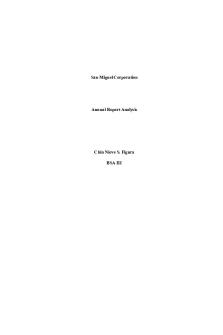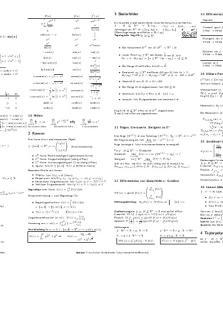Break-Even Cross-Over Analysis 2 PDF

| Title | Break-Even Cross-Over Analysis 2 |
|---|---|
| Author | Jenny P |
| Course | Operations Management |
| Institution | George Mason University |
| Pages | 4 |
| File Size | 129.8 KB |
| File Type | |
| Total Downloads | 99 |
| Total Views | 541 |
Summary
break even hw ...
Description
Break-Even and Cross-Over Analyses
The Generalized Profit Model: A decision-maker will break-even when profit is zero. We will develop the formula for the break-even point by setting the generalized profit model equal to zero, and then solve for the quantity (Q). For simplicity, we will assume that the quantity produced is equal to the quantity sold. This assumption will be relaxed in the chapter on decision theory. Profit (π) = Revenue (R) - Cost (C) Revenue (R) = Selling price per unit (SP) x Quantity sold (Qs) Cost (C) = [Variable cost per unit (VC) x Quantity produced (Qp)] + Fixed Cost (FC) For now, Let Qp = Qs Therefore, π = R-C π = (SP*Q)-[(VC*Q) + FC] π = SP*Q - VC*Q - FC π = (SP-VC)*Q - FC If Contribution Margin (CM) = SP-VC, then… π = CM*Q - FC, and
Q = (FC + π)/CM
From this formula, we can determine the quantity to produce and sell that will yield a profit of π dollars. For example: If fixed cost is $150,000 per year, selling price per unit (SP) is $400, and variable cost per unit (VC) is $250, what quantity (Q) will produce a profit of $300,000? CM = SP - VC = 400 - 250 = 150 Q = (FC + π)/CM = (150,000 + 300,000)/150 = 450,000/150 = 3000 units
Breakeven Point: By setting π = 0 and solving for Q, we find the break-even quantity, as follows: 0 = CM*QBE - FC FC = CM*QBE FC/CM = QBE
Q
BE
= FC/CM
For example, if: FC = 150,000 VC = 250 CM = 150 SP = 400
}
QBE = 150,000/150 = 1000 units
Pictorially:
Π Break-Even Point
0 1000 -150,000
Q
Cross-Over Point (Indifference Point): The cross-over (or “indifference”) point is found when we are indifferent between two plans. In other words, this is the value of Q when profit is the same for each of two plans. To find the cross-over point for Plan A and B:
πA = CMA*QA - FCA Set πA equal to πB and solve for value of Q
πB = CMB*QB - FCB Let’s call this “cross-over point” (between Plans A and B) Q “AtoB” (or, in general, “Qco”). Therefore, setting the two equations equal to each other and solving for Q:
Q
AtoB
= (FCA - FCB)/(CMA - CMB)
To illustrate the cross-over point, let’s look at three strategies or plans: Plan A 150,000 250 400
FC VC SP
}
Plan B 450,000 150 250 400
}
150
Plan C 2,850,000 100 300 400
}
Breakeven Points for each plan are:
QBE =
Plan A 150,000/(400-250)
Plan B 450,000/(400-150)
= 1000 units
= 1800 units
Plan C 2,850,000/(400-100) = 9500 units
And, by definition, the profit at each break-even point is zero. Crossover Points:
QCO
A to B (150,000-450,000)/(150-250) = 3000 units
πA =atCM - FCA point is: A*Q And since π = CM*Q - FC, the profit each cross-over
B to C (450,000-2,850,000)/(250-300) = 48,000 units
πB = CMB*Q - FCB
= 150(3000) - 150,000 = 250(48,000) - 450,000 = $300,000, or
πB = 250(3000) - 450,000 = $300,000
= $11,550,000, or
πC = 300(48000) - 2,850,000 = $11,550,000
To interpret the answers, we are “indifferent” between Plan A and Plan B when Q = 3000 units, and either Plan A or B would yield a profit of $300,000 when Q = 3000 units. We are also “indifferent” between Plan B and Plan C when Q = 48000 units, and either Plan B or C would yield a profit of $11,550,000 when Q = 48000 units. Pictorially: KEY: A B C
Π
NOT TO SCALE
Crossover Points
Q 3,000 48,000
Below 1000 units, none of the strategies would break-even. And remember that the generalized profit model above can be used to find the amount of profit for a plan at any value of Q. Therefore, depending on the number of units produced and sold (Q), the best plan to pursue would be as follows:
Units (Q) 0-999 1000-2999 3000 3001-47,999 48,000 >48,000
Decision Don’t produce Plan A Plan A or Plan B Plan B Plan B or Plan C Plan C...
Similar Free PDFs

Solutions Breakeven Analysis
- 6 Pages

Cash Breakeven Analysis
- 2 Pages

Breakeven Analysis notes
- 11 Pages

3.3 Breakeven
- 17 Pages

Crossover point in years
- 2 Pages

Breakeven multi products
- 4 Pages

Exercises Breakeven point & ROE
- 3 Pages

Financial analysis 2 - IA 2
- 25 Pages

Case analysis 2 Target
- 4 Pages

Sensitivity Analysis 2
- 2 Pages

SWOT Analysis Example-2
- 4 Pages
Popular Institutions
- Tinajero National High School - Annex
- Politeknik Caltex Riau
- Yokohama City University
- SGT University
- University of Al-Qadisiyah
- Divine Word College of Vigan
- Techniek College Rotterdam
- Universidade de Santiago
- Universiti Teknologi MARA Cawangan Johor Kampus Pasir Gudang
- Poltekkes Kemenkes Yogyakarta
- Baguio City National High School
- Colegio san marcos
- preparatoria uno
- Centro de Bachillerato Tecnológico Industrial y de Servicios No. 107
- Dalian Maritime University
- Quang Trung Secondary School
- Colegio Tecnológico en Informática
- Corporación Regional de Educación Superior
- Grupo CEDVA
- Dar Al Uloom University
- Centro de Estudios Preuniversitarios de la Universidad Nacional de Ingeniería
- 上智大学
- Aakash International School, Nuna Majara
- San Felipe Neri Catholic School
- Kang Chiao International School - New Taipei City
- Misamis Occidental National High School
- Institución Educativa Escuela Normal Juan Ladrilleros
- Kolehiyo ng Pantukan
- Batanes State College
- Instituto Continental
- Sekolah Menengah Kejuruan Kesehatan Kaltara (Tarakan)
- Colegio de La Inmaculada Concepcion - Cebu




